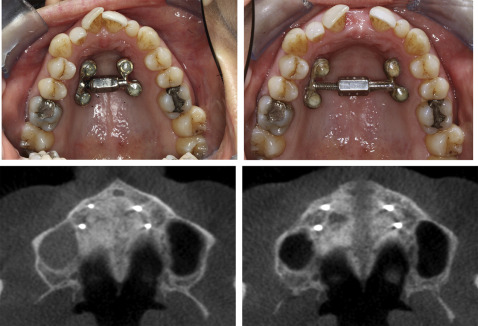In a case report in the May 2016 issue, Carlson et al reported the use of a microimplant-assisted rapid palatal expansion (MARPE) appliance to correct transverse maxillary deficiency in an adult (Carlson C, Sung J, McComb RW, Machado AW, Moon W. Microimplant-assisted rapid palatal expansion appliance to orthopedically correct transverse maxillary deficiency in an adult. Am J Orthod Dentofacial Orthop 2016;149:716-28). The report was interesting and very systematic, but it was missing some important details.
As the authors stated in their introduction, true skeletal expansion is free of dental and alveolar side effects, and only pure skeletally anchored expanders can achieve this. However, the appliance used in this case report, a MARPE appliance, is a dentally and skeletally anchored expander with evident dental (molar) side effects. MARPE means mini-implant “assisted” rapid maxillary expansion, which expresses skeletal anchorage in additional to dental anchorage. These appliances are subsumed under the “hybrid” type of expanders as reported by Wilmes and Drescher and Ludwig et al. Hybrid expanders use mini-implants in the lateral anterior palate and the maxillary first molars as anchorage. The MARPE is a hybrid expander because it is anchored on 4 mini-implants in the lateral posterior palatal region and the maxillary first molars. To clarify anchorage definitions, a term such as BAME should be used, for pure “bone-anchored maxillary expanders.” The letter R, for “rapid,” should be omitted, because thanks to solid anchorage, these expansions can also be performed in a slow way. This technique was presented with the Micro6-expander in 2013 ( Fig ).

Explaining the outcomes of their rapid palatal expansion, the authors described “uprighting” of the maxillary first molars. The change in degrees indicates buccal tipping of those molars, a highly undesirable side effect with a high risk for periodontal harm or root damage.
Pure bone-borne expanders do not show any translational dental movements or buccal tipping because no teeth are involved. After the expansion, they even show minor spontaneous palatal tipping of the buccal teeth, as Carlson et al described for the maxillary canines only. In this case report, the mini-implant- and molar-anchored expander was opened 10 mm, achieving an overall palatal widening of 6 mm between the first molars. Now the question arises, what has happened to the missing 4 mm? Four millimeters of anchorage loss (2 mm per side) in this young adult would mean either that the implants have moved through the bone, or the implants have tipped or deformed, or even both. A cone-beam computed tomography cross-section image of this region could have answered this question and given visual information about the bone height and the situation around the mini-implants, although as stated in the Treatment progress section, an image with the appliance in place had been taken. Why was it not presented in this case report? Why is there is not a single photo of the appliance before or after expansion in this presentation? The estimated average bone height in this region (16 mm behind the incisive foramen and 7 mm lateral of the midline) is around 3 mm. How much higher is the anchorage loss in older adults (>25 y) with more resistance against expansion due to more mature bone? According to the examinations by Walter et al, directly loaded titanium mini-implants with a diameter of 1.5 mm under these circumstances will undergo major deformations with the risk of breakage. According to this study, hybrid expanders with dental anchorage and the assistance of 2 to 4 mini-implants should be used only in adolescent patients, not in adults. In a study of 33 adults with pure BAME, 90% of the patients between 23 and 33 years (n = 11) had successful palatal widening without SARPE and no dental side effects.
In this letter, we have focused on different types of anchorage for palatal expanders. Thorough treatment decisions should be made according to the patients age in regard to appliance design and opening protocol (rapid vs slow vs polycyclic). The challenges, however, are to prevent dental side effects and to enable palatal widening in even mature adult patients without SARPE.
Stay updated, free dental videos. Join our Telegram channel

VIDEdental - Online dental courses


